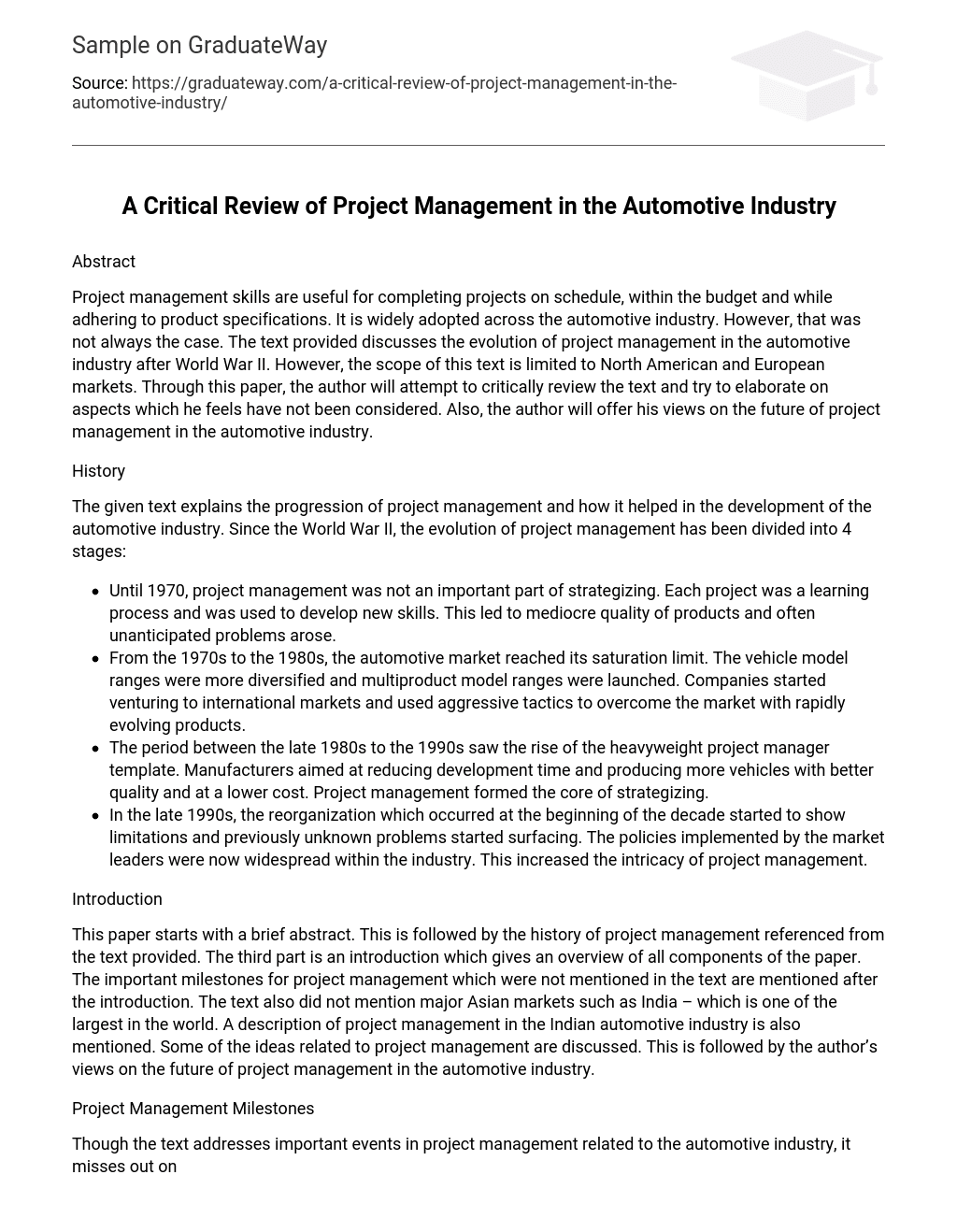Abstract
Project management skills are useful for completing projects on schedule, within the budget and while adhering to product specifications. It is widely adopted across the automotive industry. However, that was not always the case. The text provided discusses the evolution of project management in the automotive industry after World War II. However, the scope of this text is limited to North American and European markets. Through this paper, the author will attempt to critically review the text and try to elaborate on aspects which he feels have not been considered. Also, the author will offer his views on the future of project management in the automotive industry.
History
The given text explains the progression of project management and how it helped in the development of the automotive industry. Since the World War II, the evolution of project management has been divided into 4 stages:
- Until 1970, project management was not an important part of strategizing. Each project was a learning process and was used to develop new skills. This led to mediocre quality of products and often unanticipated problems arose.
- From the 1970s to the 1980s, the automotive market reached its saturation limit. The vehicle model ranges were more diversified and multiproduct model ranges were launched. Companies started venturing to international markets and used aggressive tactics to overcome the market with rapidly evolving products.
- The period between the late 1980s to the 1990s saw the rise of the heavyweight project manager template. Manufacturers aimed at reducing development time and producing more vehicles with better quality and at a lower cost. Project management formed the core of strategizing.
- In the late 1990s, the reorganization which occurred at the beginning of the decade started to show limitations and previously unknown problems started surfacing. The policies implemented by the market leaders were now widespread within the industry. This increased the intricacy of project management.
Introduction
This paper starts with a brief abstract. This is followed by the history of project management referenced from the text provided. The third part is an introduction which gives an overview of all components of the paper. The important milestones for project management which were not mentioned in the text are mentioned after the introduction. The text also did not mention major Asian markets such as India – which is one of the largest in the world. A description of project management in the Indian automotive industry is also mentioned. Some of the ideas related to project management are discussed. This is followed by the author’s views on the future of project management in the automotive industry.
Project Management Milestones
Though the text addresses important events in project management related to the automotive industry, it misses out on some important aspects which helped shape the field of project management. For example, Gantt charts are used to determine the duration and sequence of tasks in a process. In the mid twentieth century, Program Evaluation and Review Techniques (PERT) charts and critical path method were established. The US Department of Defense expected their contractors to adhere to project management standards. Data was later utilized to develop project management and evolve theories and procedures. International establishments such as the Project Management Institute (PMI) and International Project Management Association (IPMA) launched project management training initiatives for professionals. They also set standards and documented widely accepted practices. They also hold events to spread awareness of their practices.
Project Management in the Indian Automotive Industry
The automotive industry is one of the most important industries in India. Any major effect in the Indian automotive market would have ripple effects all over the world.
Future of Project Management
According to a recent study conducted by a product development company, corporate performance is a direct consequence of product development. Though most companies follow similar corporate strategies, certain establishments create their advantage by superior execution. These companies enjoy much higher profit margins and rates of revenue growth. With the increased significance of outsourcing or development and manufacturing, the importance of coordination and project management will be greatly increased. The product development requirements for growth depend upon the stage which the company is at. Some companies may focus on revenue growth while others may prefer profitability. However, it was found that the market leaders are those companies which invested more into research and development per employee and are likelier to support fewer product platforms. Hence, they can invest more in each project. Another important advantage was that this strategy makes the market leaders better at managing engineering changes. These companies place a huge emphasis on services and create much more revenue from services as compared to lower ranked companies. Rather than develop a single strategy, there must be different strategies depending on market standing. Each type of company must adopt different agendas for product management.
Market leaders must focus on exploring newer markets, developing their corporate strategy and build on their advantages. They must set a structure in place to support innovation and improve standardization for efficient allocation of resources.
The most innovative companies usually have strong but narrow product lines. Such companies must look at expanding their product portfolio and maturing their products. This can be done through collaboration. A good portfolio strategy can reduce the effort and investment while also increasing the market share.
Companies struggling to innovate can work on improving their market reach, develop collaboration tools and reduce development costs.





